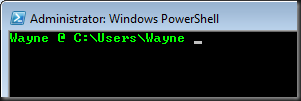PowerShell Profiles and Prompts
To get the path of your PowerShell profile, you can use the built-in $Profile variable. If your profile exists, you can open the profile in notepad using the Invoke-Item cmdlet.
If the profile doesn't exist, as you create it using the New-Item cmdlet. To make sure you can create the file even if part of the path doesn't already exist using the -Force parameter.
Once the profile has been created, you can open it with the Invoke-Item cmdlet.
To customise the PowerShell prompt, you can create a prompt function like I have below.
You could include some Environmental variables in the prompt function to make the PowerShell prompt provide some very useful information, for example:
You can also customise the UI using your profile. This is done by modifying properties of the $Host built-in variable.








